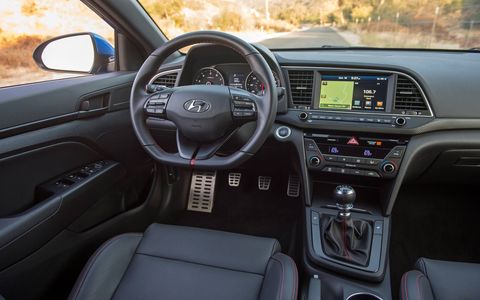2017 Hyundai Elantra Sport review: A good effort in a tough class
Gallery: 2017 Hyundai Elantra Sport

I know someone considering a new Corolla for his kid. I said “before you pull the Corolla trigger, you might want to check out the Hyundai Ela –” and before I could finish my sentence he said, “Yeahno. A Hyundai ain’t gonna happen. They’re just bad cars.” That’s not true, but even though we’ve written story after story on Hyundai’s improvements, there’s still a stigma that it makes cheap cars that aren’t as good as the competition.
This Elantra Sport is a perfect example why that reputation might be lingering. The car is OK, but if you think of it in terms of a Mazda 3 or VW Golf, it’s simply not good enough.
Why not? After all, the Sport offers some big-time quote unquote improvements over lesser Elantras, like the more powerful turbo-four, multi-link rear suspension and upgraded brakes. So what’s the problem? The Sport is an almost car: Almost fast enough, handles almost well enough, the steering is almost communicative enough …
The ride quality is a wee bit firmer than I remember from previous Elantras, but then again, this is the Sport model, so one can expect it. The turbo-four cranks out good power but doesn’t sound as refined as competitors.
The interior is almost good enough, too. It’s dramatically better then the last Elantra but (beating this dead horse) not as good as a Golf in terms of quality materials and fit and finish and refinement. I do like Hyundai’s center screen interface, clear and intuitive.
This is a better Elantra, no doubt. If you’re looking for a sporty little runabout in the GTI/Mazda 3 orbit, though, the Elantra Sport probably isn’t for you. You’d be settling. Based on other Hyundais I’ve driven, I frankly expected better.
–Wes Raynal, editor
Gallery: 2017 Hyundai Elantra Sport interior

OTHER VOICES:
Hyundai doesn’t quite have the sporty car thing down yet. It’s getting closer, as evidence with this turbocharged, dual-clutch’d Elantra Sport, but I was hoping for a little more.
I think it looks like a waterbug, especially in this black coat of paint. It suffers from what most small sedans suffer from, which is the wind tunnel. It seems Ford, Chevy, Dodge and many of others have found that this jelly bean shape is perfect for cheating the wind. That means that if you stack up the Fusion, Dart, Cruze and Elantra in a row, they’ll all disappear behind each other’s roof lines. I do like the front-end treatment here, with the snub nose.
Inside, it’s black on black on black, perfect for this sort of car. It does have acres of plastic, but with a $23,000 base price, that’s what we expect. The seats are medium soft, but I hate when there’s no height adjustment for the front. Like many of the Toyotas and Nissans, if feels like I’m falling forward in the seats. The radio/infotainment would get confused when I plugged my iPhone in before everything was booted up, but I do like that you can use both Apple CarPlay and the native navigation system simultaneously. The controls are easy with knobs for the main functions like volume and climate.
Like the Kia Soul Turbo, this Elantra Sport, with the same 1.6-liter turbo, just doesn’t have enough oomph. I know this isn’t a sports car, but if you’re playing in the GTI-Focus ST-Civic Si price range, it needs to feel surprisingly sporty like the rest do.
Once you get going, the Elantra does have plenty of power to speed past traffic. Getting off the line, it is a little slow, though. It choked up a few times in the mid-rev range, too.
The dual clutch transmission is among the smoother ones out there. It doesn’t get herky-jerky slowing to a stop or speeding off the line. On the other hand, that probably contributes to the sluggish feel. The shifts are about average speed. I played with the shift paddles a little bit, but they’re not nearly as quick to change as the VWs gearbox. It should be much more aggressive. If you want a slow, smooth and quiet Elantra, get the cheapo base model.
Steering feel is non-existent. I was taking a curved expressway on ramp and was literally laughing at how you can yank the wheel around without feeling any change in resistance. Sure, you can hear the tires at a certain point, but there’s no road feel at all.
I haven’t driven the Si yet, but I can say for sure that this isn’t up to the level of hot sedans and hatches from VW, Ford and the like. We’re still waiting for a new MazdaSpeed 3. I will say, like Wes did, that I’d recommend the Elantra specifically and Hyundai in general to anyone looking at a base Corolla, Focus or Jetta.
–Jake Lingeman, road test editor
Options: Premium Package for Sport, including navigation with 8-inch touchscreen, Infinity premium audio with eight speakers and subwoofer, Clari-Fi Music Restoration Technology, Blue Link Connected Care, Power tilt-and-slide sunroof, blind spot detection with rear cross-traffic alert, dual automatic temperature control, auto-dimming rearview mirror with Homelink and compass ($2,400); carpeted floor mats ($125)
Vehicle Model Information
ON SALE: Now
BASE PRICE: $23,585
AS TESTED PRICE: $26,110
POWERTRAIN: 1.6-liter DOHC turbocharged I4; FWD, seven-speed dual-clutch automatic
OUTPUT: 201 hp @ 6,000 rpm; 195 lb-ft @ 1,500-4,500 rpm
CURB WEIGHT: 3,109 lb
FUEL ECONOMY: 26/33/29 mpg
PROS: Nicely outfitted compact sedan
CONS: “Sport” doesn’t translate into much actual sportiness






